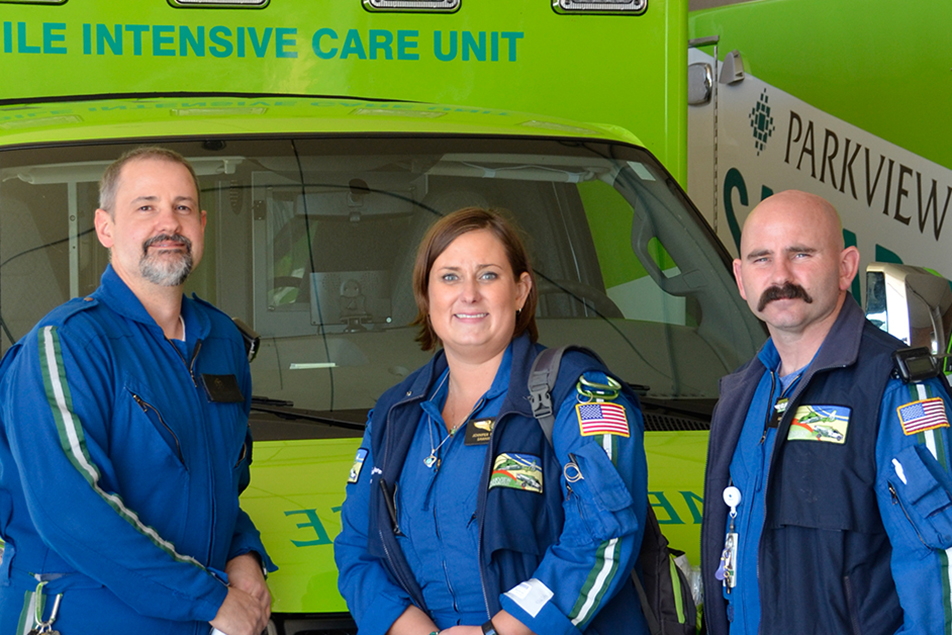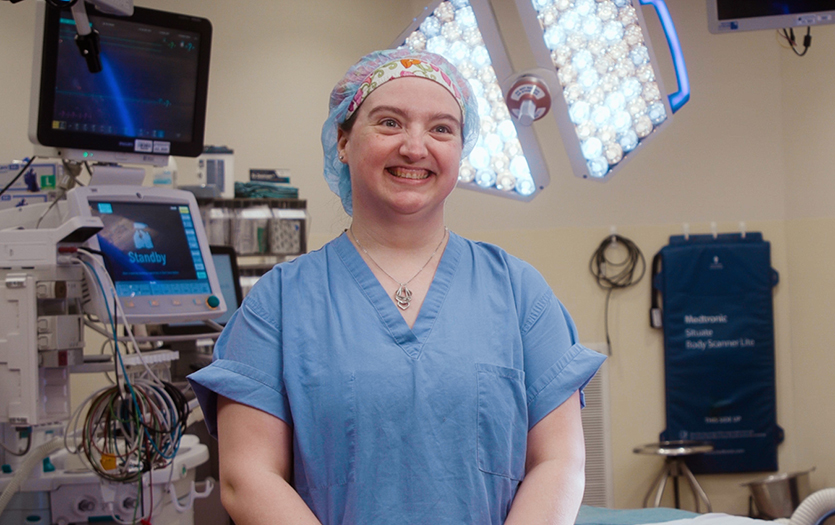
This blog post was written by Courtney Leach, digital/social media manager for Parkview Health.
I sent my text message at 7:35 a.m.
“In the ER. Can you come get me?”
I looked out the window. Sleepy, anxious visitors were shuffling in to greet loved ones at the earliest acceptable hour. Caregivers were leaving from the long night shift, thoughts of others lingering in their heads. An ambulance, with lights but no siren, turned off Parkview Plaza, then disappeared behind the building. The passersby and the heaviness the day potentially promised for them made me feel silly for entertaining my own nervous stomach. I always feel a little anxious before these shadowing experiences. My mind gets carried away with thoughts of dramatic scenarios and Thursday night TV drama storylines. None of which ever come to fruition. But more than anything, I worry about my ability to adequately convey the fearless, life-saving, awe-inspiring work of the people I follow after the whole thing is over.
My phone vibrated. The message read:
“Of course! Be right down.”
Just a minute later, that familiar royal blue jumpsuit and the warm face of Jennifer Esslinger, RN, MICU transport nurse, emerged from the double doors. There was just something about Jenny. I met her on the second day of my Samaritan fly along last summer. She didn’t coddle me, but I felt like she was looking out for me. She was focused but friendly. Seasoned but curious. And she felt like the absolute best person to educate me now on our Mobile Intensive Care Unit (MICU), since she’d been with the program since its introduction in 2010.
We caught up over our elevator ride, eight floors up. She’s working on her bachelor’s degree, her kids are doing well, things are busy as ever. We walked into the team’s office and various Samaritan crew members eventually funneled in. Their morning chatter was just as I’d remembered. Recaps of the prior shift, playful jabs at a fellow team member, an update from a troubling case a few weeks back. The details were different, but the spirit and the players were the same. “We’re not normal up here,” someone said in my direction. I’d heard them say that before, too. I smiled.
I met the rest of the crew; Kerry Passwater, paramedic, and Randy Linker, EMT. People always greet me with a tentative warmth in these situations. I think it has something to do with the giant camera I wear around my neck and notebook resting on my forearm, pen poised for documentation.
We walked out to the hospital carport where the Samaritan ground fleet is parked. There, the old MICU, which is now used as a backup, Critical Care Transport (CCT) and an ambulance were lined up, charging and standing by. The current MICU is actually the third for the team. “We average 100,000 miles a year, so it makes sense,” Jennifer said.
I stepped onto the metallic stairs and pulled myself up into the back of the MICU. Having been inside the helicopter, I immediately noticed how broad and airy this felt by comparison. Jennifer settled into the generous, nearly chartreuse, chair next to me and started running through the morning equipment check. I looked on, waiting for the appropriate time to start lobbing questions in. I was ashamed to admit how meager my MICU knowledge really was heading into the day.
As soon as I saw an opening, I asked Jennifer about her history with MICU. “Well, I always wanted to be a flight nurse,” she said. “When I went to interview, they told me about this ‘new thing’ they were starting up. Honestly, I’d never heard of a MICU. The concept was still fairly new at that point.” The initiative was presented to Jennifer and others as an alternate mode of transportation in the event the helicopter wasn’t available, though, in its 7-year history there have been times it veered from that vision.
Watching Jennifer check equipment and light up as she enthusiastically recounts the MICU’s grassroots history, it’s clear she is one of the program’s greatest champions. She takes a great deal of pride in the truck’s condition. Does it have the right amount of alcohol pads? Is the trash emptied? Are the harnesses buckled? It’s a pride that comes with a passion for your occupation. “I love that I have time to talk to the patients on here,” she shared. “I had a patient once who was terrified because he thought they were going to put him on dialysis. Because of our transport, I had about 20 minutes to explain the dialysis process to him, and you could just see the calm come over him. We had the time, he could hear me, and it made a difference.”
We arrived at Leo High School and met up with Scott and Heather Yoder. Scott, paramedic, is a EMS Chief for the Northeast Fire Department as well as a full-time flight medic for Samaritan. Heather, RN, is the Assistant EMS Chief for the Northeast Fire Department and nurse lead in the Parkview Emergency Department. This entertaining group of first responders would be teaching CCR to three classes full of students.
The restless teenagers were still flicking fidget spinners and chatting about prom that weekend when Thomas Dykstra, PEP – emergency medicine, who’d been volunteering with the class, stepped to the middle of the room. “This is the one time in your life you can actually bring someone back to life,” he said. “It could be someone in your home, on the basketball court, or your best friend.”
The class broke up into groups of 4 or 5 and a first responder joined them. They reviewed and practiced CCR and how to properly use the AED machine. In 2006, the trend shifted to teaching CCR alongside the traditional CPR. It stands for Cardiac-Cerebral Resuscitation, and it means life-saving efforts are made using hands only. If good compressions are being administered mouth-to-mouth isn’t necessary because the victim is getting oxygen. Here is what I learned in my time observing:
- When delivering CCR, place your hands on top of each other, on the victim’s chest. Bring your shoulders up over your arms so you are staring straight down at the victim’s armpit opposite your body.
- Make sure their back is on a hard surface. If it isn’t, move them to the ground as quickly as possible to begin CCR.
- If you’re alone, call 911 right away and put them on speaker phone.
- If you are not alone, point and designate specific actions for specific people. “You call 911.” “You get the AED machine.”
- You can administer compressions to the rhythm of Row, Row, Row Your Boat.
- Only stop compressions when the AED machine administers the charge. If you are working with a partner for the CCR, have a countdown to exchange efforts so there isn’t a break in compressions.
- Make sure the AED machine pads are on bare skin.
- If the victim is a small child, you can administer compressions using two fingers.
- A first responder will typically arrive within 5 minutes of calling 911.
- The worst thing you can do is nothing at all.
There was a small break after the morning sessions, so we decided to grab some food. “That’s one thing about this job,” Jennifer said. “You learn to eat when you can.” The vehicle was still running, which is both for quick response and to charge the equipment, though there’s a generator in case the power goes out. We drove first to the Northeast Fire Department station to strategize our early lunch, but we’d be making those arrangements ourselves. Soon after arriving, the alarm sounded and the team had to go make an elevator rescue. Apparently I was getting a two-for-one bargain on behind-the-scenes experiences today.
Over lunch, I finally had a chance to chat with Randy, the EMT. Randy, who’s worked with the MICU part time for the last 3 years, drives the ambulance for both the Auburn and New Haven Fire Departments as well, which you see a lot in this professional circle. The first responder community – composed of firefighters, police officers, EMTs, paramedics and nurses – is a converging, exclusive web of heroics. While it feels very exclusive in nature, everybody seems to know everybody at the same time. Each unique labyrinth of shifts born from a need to help where and when they can.
I was curious what goes through Randy’s mind when he’s driving. “It’s very rare we go lights and sirens,” he said. “People just don’t see or hear us anymore. They’re distracted, on their phones. And if I blow through an intersection and hurt someone, that’s on me.” There’s a law known as “Due Regard,” which essentially means an ambulance driver can’t do whatever he or she wants. They have to obey the laws like anyone else. “A lot of times, blowing all the bells and whistles doesn’t get us there that much faster anyway. They’ll let me know if I need to speed up.” “We have what we need and we’re trained to deal with almost anything. We can deliver a high level of care, so it’s not typically a frantic situation,” Jennifer added.
We returned to the high school for the next session. Shortly after the groups assembled, the MICU got a call. On a typical day, the team will make 1-2 runs. In this case, a patient needed transferred from Parkview Hospital Randallia to Parkview Regional Medical Center. Transfers happen for a number of reasons – they need to be under the care of a particular specialist or require a certain technology that’s only available at one location. In this instance, we would be taking the patient from one Intensive Care Unit (ICU) to another.
The call gave me a chance to watch Kerry and Jennifer in their element. Kerry joined the MICU crew just 6 months after Jennifer, in October 2010, though the two have only been partners for two years now. He sits at the head of the patient and Jennifer sits at their side.
We pulled into Randallia and snaked through the halls to the ICU. After a bit of briefing, the group grew almost entirely silent, rearranging IV pumps and ventilators. Individual bodies became a bustling sea of blue; Jumpsuits and scrubs jumbled together in a focused, deliberate dance. Their efforts collected, forming a warm blanket of care held together by threads of equipment, training and experience. I would understand later, but this was the first part of building a bridge in the patient’s care.
The teams worked meticulously through the transfer, even taking a few extra minutes to place a sling under the patient for easy bed transfer at the next destination. Nothing felt frightening or frantic, though critical care was certainly on everyone’s mind.
When it was time go, we retraced our steps back to the MICU, Jennifer and Kerry settling into a dialogue which would be constant from this location to the next. They rattled off numbers and confirmed dosages. They came alive the second they assumed responsibility. There was no wavering or hesitation. This was their lane.
Once on the road, it was the MICU that came alive. Because of the smart design, which the team had input on, the medic and nurse can both reach everything they need while still buckled in. They can start an IV while moving (a skill you acquire when you log this many miles). They can run eight drips, have an IV pump, fluid warmer, two units of blood, fresh-frozen plasma, ICU medications, a high-tech ventilation system, and a liquid oxygen system that’s easy to refill so they never run out. They can do balloon pumps and cardiogenic shock. And above everything else, because they have the technology and the skills they have, the MICU allows the team to truly support these critical patients.
We were 6 minutes out. Kerry radioed Parkview Regional Medical Center with an update and estimated arrival time.
We pulled in and took the patient up to the ICU. Again, a team of nurses went about the choreography of transferring care. A bath was prepared. His medications moved over. And when it came time to shift him to his new bed, the receiving team expressed something that perhaps isn’t part of the typical protocol … gratitude. Because extra care was taken at Randallia, and the sling was placed under the patient, an often exhausting and tricky task was quite simple on this day, in this transaction. The patient was transferred smoothly and efficiently. The second part of the bridge had been built.
The value of the MICU was quite clear to me by now. It’s about facilitating a gentle continuum of care. They are the link, the plank, the arch that quietly, but attentively, ushers these patients from one point of high-level treatment to another, without disruption. When the quality of care is uninterrupted it can mean better outcomes 24, 48 or 72 hours out. And when you’re dealing with the level of severity this team is, that continuum makes a big difference. The patient is getting the same drips, same ventilator, same drugs as they do in the ICU. And the entire process is safer and more controlled.
Additionally, leveraging the MICU for transfers from some of our community hospitals can mean these smaller areas don’t have to lose access to their only available emergency vehicle. “If the patient is stable and they have what they need, it’s worth it to wait 20 minutes for us to get there to avoid a disruption in their progress,” Jennifer explained. “People underestimate the trauma of moving a high-risk patient. It can set the patient, and all the work the care team has done to achieve improvements, back. Intensivists recognize the benefits and have a great deal of respect for us, and us for them. We work well together.”
After the transfer was complete, Randy, Jennifer and Kerry went about the business of preparing for the next call. They wiped down the gurney, unfolded and spread out fresh sheets and repositioned their gear. Not a word was spoken between the three of them as they went about the business of resetting their equipment. It was a routine, a superior performance on a familiar stage.
We went back up to the office so the team could chart. Randy went back down for fuel and to park the MICU. Knowing my day was winding down, I surveyed my list of unanswered questions and asked Jennifer and Kerry what they thought the biggest challenge was regarding their job. “Getting people to see the value and the difference in what we do,” Kerry said, and Jennifer agreed. “It’s still a new concept to some,” she added.
When it came to forming the MICU crew, it was decided the program would follow the Samaritan flight crew model: an EMT at the wheel, and paramedic and nurse in the back. It a combination that’s proved to work time and time again. When I asked about the value of their team model, it was obvious opinions had evolved. “As a paramedic, we’re trained to work alone,” Kerry said. “We’re trained to do with what we have, no matter what the scenario is, and the scenario is almost always going to be different. I had to learn to work with someone.” But once he did, the value was undeniable. “Nurses are always trained to look into the future. I’m used to the here and now. Working with someone like Jennifer forces me to slow down and really notice things rather than just act.” Jennifer nodded. “Yeah, we’re thinking, OK, this person was in an accident, but what happened right before that? A medic is thinking about steps 1 and 2, while I’m thinking about steps 3 and 4. So, it works really well.”
Randy joined us, and I posed the same questions to him. “Paramedics are trained on the street and nurses are trained in house, so in this case, you get the best of both worlds. I tell all my coworkers at the Fire Department about the insane amount of knowledge with these blue suits up here.”
And speaking of those suits, they certainly come with some notoriety. They’re hard to miss and, for those who know what they represent, demand a good deal of respect. So, is MICU (who wears the same uniform as the flight crew) often compared to their Samaritan comrades? “I always thought MICU would be my step to the flight crew, but now I don’t want to go anywhere,” Kerry said. “And it’s not about the suit anymore,” Jennifer, who works for both crews, added. “It’s about what it symbolizes. This mode of transport is so controlled, so smooth. It’s about what we can do for these high-risk patients.”
This team, in their signal blue suits, is a trio of torchbearers. Their comprehensive habits and meticulous processes are a tribute to putting the patient’s unique needs above other factors. Their service is an exemplary asset to progress and optimal outcomes. And the individuals who make those outcomes possible are as sharp and proficient as they come.
As I packed up my camera and notebook, I turned to take one last look out of the windows on the 8th floor. There’s something about the air up here; It smells like heroism and looks like hope. I thanked the team for their openness and rode the elevator back down to the ground level, where I enjoy only the occasional blue suit sighting. But when I do, I always smile, knowing what I know about the exclusive group of brave men and women waiting just below the clouds with all the tools they need to build a bridge.



